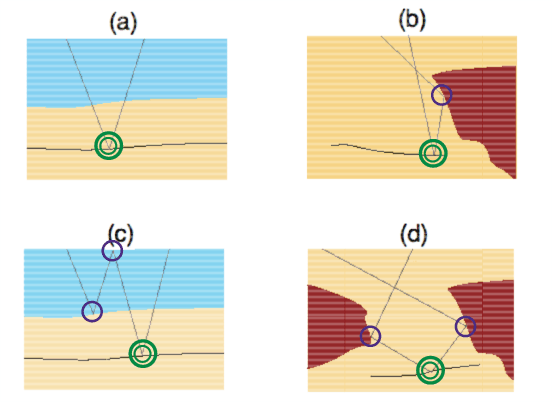|
|
|
|
Imaging with multiples using linearized full-wave inversion |
The well-known multiple-removal tools such as deconvolution (in time, frequency, and slant-stack domains), Radon-transform demultiple and frequency-wavenumber (f-k) demultiple are limited unless the geology of the subsurface is simple. In the presence of complex geology, multiples are not totally separable from primaries by criteria such as periodicity, moveout velocity, and spectra. In model-based technique, which predict multiples with wavefield extrapolation (Berryhill and Kim, 1986; Morley, 1982; Wiggins, 1988; Lu et al., 1999), the accuracy of the predicted multiples strongly depends on the model used. Surface-related multiple elimination (SRME), a convolution-based technique (Tsai, 1985; Verschuur et al., 1992; Riley and Claerbout, 1976), is more generally applicable. But this method requires an overlap of source and receiver locations and cannot suppress internal multiples. Despite substantial progress in multiple elimination, complete removal of surface-related and internal multiples without distorting the primary signals remains a challenge.
One motivation to make use of multiples is that they can provide subsurface information not found in primaries. For a given pair of source and receiver, the sub-surface reflection point of a multiple is located differently than that of a primary. For a multi-shot seismic survey, migrating the multiples translates to higher fold for regions well imaged by the primaries and more subsurface illumination for regions not covered by the primaries. In addition, despite the advance of multiple suppression techniques, complete removal of all multiples from the primaries still remains a challenge. Migrating such signals would result in crosstalk artifacts. Finally, multiples are even more sensitive to velocity information than the primaries, because they travel a longer path in the subsurface. Multiple signals can potentially be used as part of an iterative velocity building tool.

|
|---|
|
LSMimage2v2
Figure 1. The ray-path for a (a) singly scattered event, (b) a doubly scattered event and (c,d) triply scattered events. Single circles (in purple) indicate scattering off the migration velocity while double circle (in green) indicate scattering off the model  .
.
|
|
|
When surface-related multiples have been explicitly separated from the primary reflections (e.g., using SRME), they can be imaged independently from the primary reflections by using shot-profile (Guitton, 2002) or source-receiver (Shan, 2003) depth migration. Muijs et al. (2007) image primary and free-surface multiples for OBS data by decomposing data into up-going and down-going constituents, followed by downward extrapolation and a 2D deconvolution-based imaging condition. All these techniques image the surface-related multiples by transforming the primary signal into a pseudo-source for migration with the multiple signals using the one-way wave equation. Recently, Liu et al. (2011) extend the technique to the two-way wave equation. While these techniques are computationally efficient, their images contain crosstalk artifacts caused by the interference of wavefields not associated with the same subsurface reflector. A robust technique is needed to get the benefit of multiple imaging without compromising image quality. We propose using linearized full-wave inversion (LFWI) to use multiple energy as signal while removing the crosstalk in the image.
In the next section, we discuss how to image with multiples with LFWI for the streamer geometry and the OBN geometry. We then show the results of our inversion scheme from a layered model and a 2D Sigsbee2B model for the OBN geometry.
|
|
|
|
Imaging with multiples using linearized full-wave inversion |